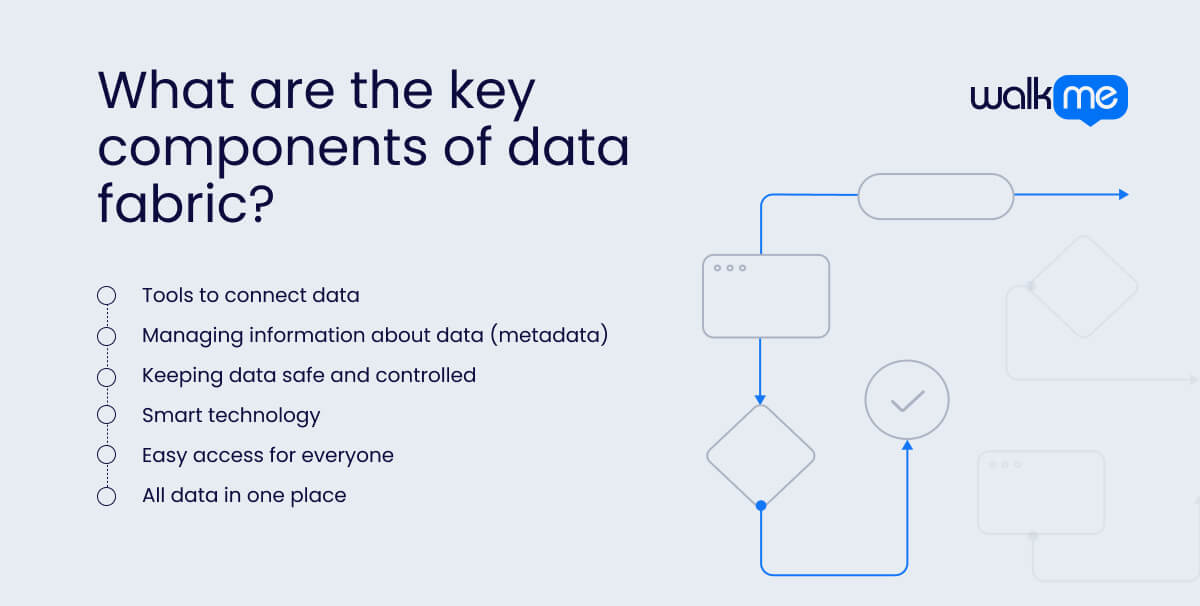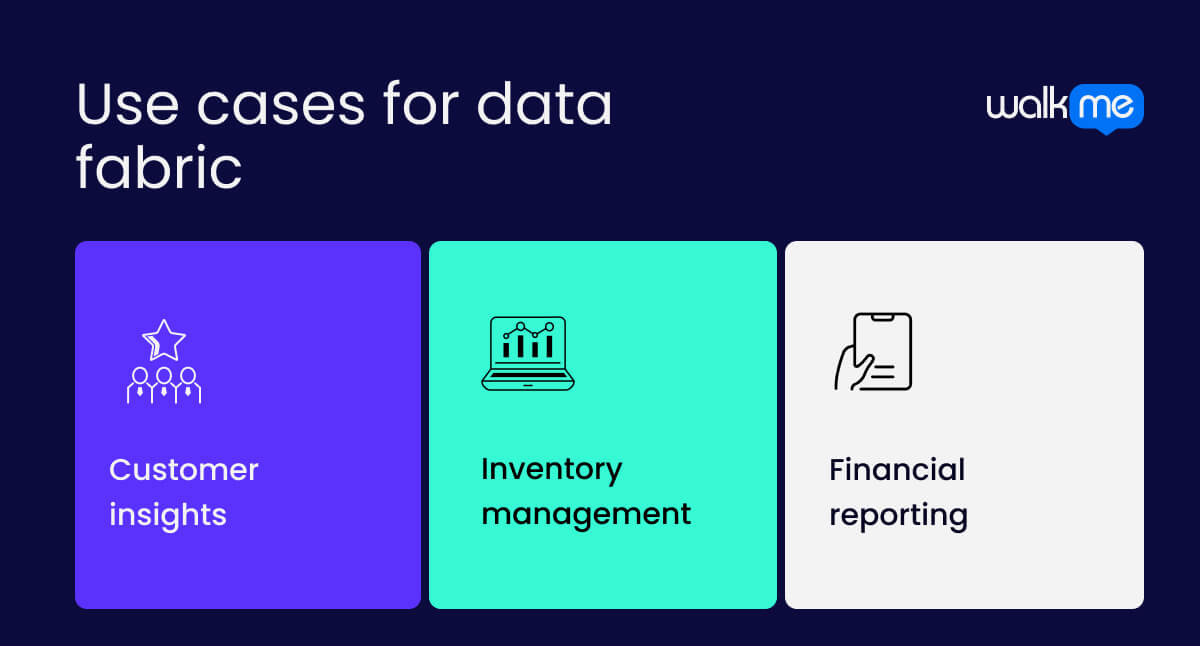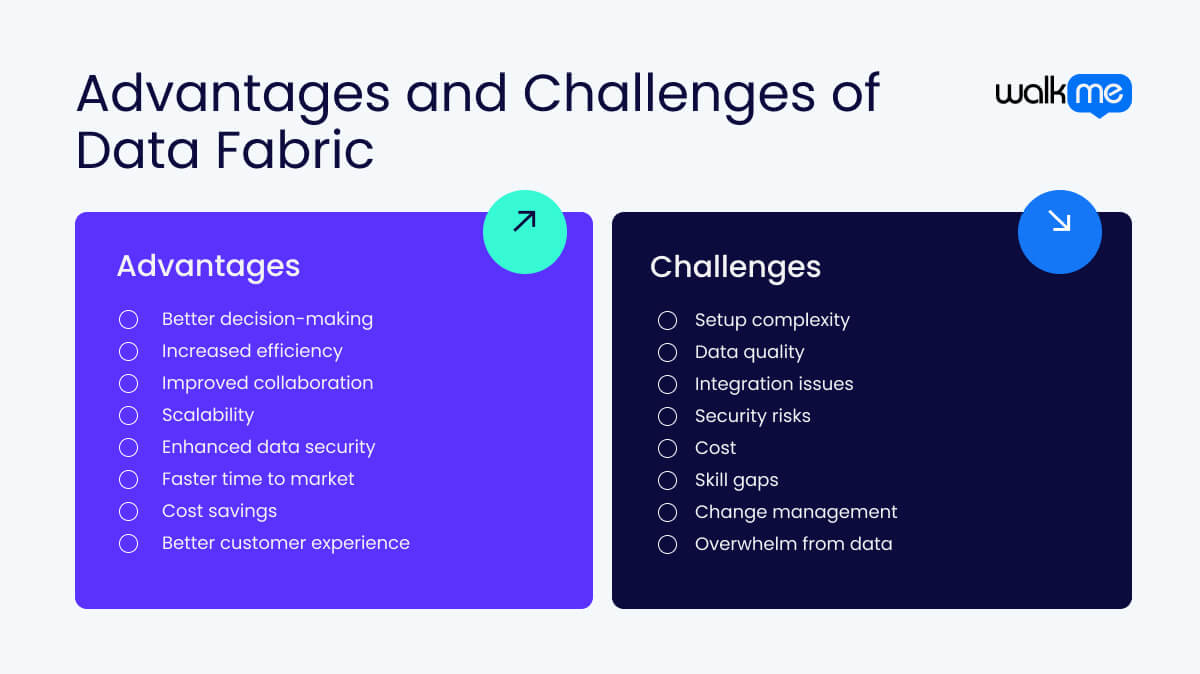What is Data Fabric?
Data fabric is a way for businesses to manage and connect all their data, no matter where it is stored. For example, it could be on a company’s own servers or in the cloud.

It helps bring different types of data together and store it in one place, making it easier for businesses to find, use, and share information. As a result, it breaks down barriers between different data systems and makes everything work more smoothly.
Data fabric uses smart tools like artificial intelligence (AI) to automatically find and organize data. It learns how different data is related and makes sure the right data is sent where it’s needed. Such a process saves time and reduces the hard work of managing lots of data manually.
With data fabric, businesses can quickly access the information they need and get insights faster, helping them make data-driven decisions.
What are the key components of data fabric?

Gartner predicts that by 2025, Chief Data and Analytics Officers (CDAOs) will use data fabric to tackle data management challenges, enabling them to focus on achieving critical digital business goals.
To understand why data fabric is so important, it helps to look at its key components. These interconnected elements make it easier for businesses to manage, access, and share data.
Let’s look at the key components that make data fabric work.
Tools to connect data
These tools help to link to different places where data is stored, so it can move easily between them.
Managing information about data (metadata)
Metadata is like a label for data, showing where it’s from and how it’s used. It helps the system to find and organize data better.
Keeping data safe and controlled
Data fabric ensures that only the right people can see certain data, keeps private information safe, and follows data rules.
Smart technology
AI and machine learning help the system automatically organize and move data, making it faster and easier to manage.
Easy access for everyone
Data fabric allows people in a business to get the data they need without needing special skills, so more people can use it.
All data in one place
Data fabric brings data from different systems together, so it’s easier to see and use.
Data fabric vs. data mesh
Data fabric and data mesh both help businesses manage their data, but they do it in different ways.
- Data fabric connects all the data in one system.
- Data mesh lets different teams control their own data, like separate products.
Let’s look at how these two ideas are different.
| Data fabric | Data mesh | |
| Definition | Connects all of a business’s data in one place, making it easy to manage and use, no matter where the data is stored. | Different teams take care of their own data, with each team in charge of their part, like separate products. |
| Focus | Creating one big system that connects and manages all data across the business. | Giving each team control over their own data, allowing them to manage it in their way while following some rules. |
| Techniques | Uses smart tools like AI and automation to link, organize, and secure data across the business. | Each team builds their own system to handle their data, but they all follow shared guidelines. |
| Goals | Make managing and using data easy by creating one big, connected system. | Give teams more control over their own data, allowing them to work faster and create solutions that fit their needs. |
| Examples of use | Used by big companies like banks or global businesses that have lots of data in different places and need to bring it all together. | Used by companies with many departments, like online stores or technology companies, where each team needs to manage their own data separately but under some shared rules. |
Use cases for data fabric

Data fabric can help in many different business situations.
It helps marketing teams understand what customers like and helps inventory managers keep track of stock.
Sometimes it can be hard to see how data fabric works in real life, so here are three examples to show how it makes a difference in different businesses.
Customer insights
Data fabric helps a company learn more about its customers. It brings together information from different sources, such as social media, website visits, and what people buy.
By collecting and organizing this data, the system creates a complete picture of each customer.
Because of this, the marketing team can see what customers like and want. These insights help them make ads that connect better with people.
Overall, data fabric makes it easier for businesses to understand their customers’ needs. They can improve their marketing and build better relationships, making customers happier.
Inventory management
Data fabric makes managing inventory in a store easier by connecting information from different sources, such as stores, warehouses, and suppliers.
The system automatically keeps track of stock levels and sales, showing real-time updates on what products are available.
With this information, the inventory team can quickly decide when to restock items and make sure popular products are always in stock. The system also helps avoid having too many items that aren’t selling well.
Good inventory management means customers can find what they want in the store, leading to more sales and a better shopping experience.
Financial reporting
Data fabric helps a company with financial reporting by gathering information from different departments, like sales, expenses, and investments.
The system automatically puts this data together into clear financial reports that are made regularly. These reports allow the finance team to quickly see important financial information and how the company is doing.
With accurate and timely reports, the finance team can make smart choices and solve any money problems. Overall, this efficient reporting process saves time and helps the company stay financially healthy and stable.

What are the benefits of data fabric?
The advantages of data fabric can help businesses a lot. By gathering information from different places, data fabric helps companies work smarter and quicker.
Let’s look closely at all the good things that come from using data fabric.
Better decision-making
A unified data approach provides businesses with a clear view of operations. Teams can make informed decisions based on reliable, shared data, allowing for quick adjustments and streamlined problem-solving, which strengthens teamwork.
Increased efficiency
Automating data collection and organization saves time and reduces errors. Teams can quickly access what they need without extensive searches, staying focused and completing tasks faster.
Improved collaboration
Easy, real-time information sharing enables departments like marketing, sales, and finance to coordinate efforts effectively, helping everyone achieve their goals and strengthening the company.
Scalability
Data fabric can grow with a business as it grows. It easily adjusts to new information and tools, making it simple to add more data without starting over from scratch. This flexibility means that businesses can keep up with new opportunities and ideas when they come, helping them be ready for whatever happens next in the market.
Enhanced data security
Access controls protect sensitive information, enabling businesses to establish clear security protocols and keep data safe from unauthorized access.
Faster time to market
Streamlined data management enables businesses to act on insights quickly, accelerating product development and helping them stay ahead of competitors.
Cost savings
Automating data processes reduces time spent on repetitive tasks, lowering costs. Greater efficiency also minimizes errors, freeing up resources for strategic areas.
Better customer experience
With a comprehensive view of customer data, businesses can tailor products and services to meet customer needs, building loyalty and enabling stronger relationships.
What are the challenges of data fabric?
While data fabric helps businesses gather information and work better, it also has some difficulties. Companies must understand these challenges to ensure the technology works well for them.
Setup complexity
Setting up a data fabric system can be difficult because it requires connecting many different data sources. Making sure everything works well together can take a lot of time and effort. Special skills or help might be needed to get everything set up correctly.
Data quality
Ensuring that all the data used in a data fabric is accurate and clean can be a big challenge. Poor quality data can lead to wrong decisions and confusion. It takes time and effort to check and fix any mistakes in the data before it can be used effectively.
Integration issues
Bringing together different types of data from various sources can create problems. Some systems might not work well together, making it hard to get a complete view of the data. Finding ways to integrate everything smoothly can be challenging and may need extra work.
Security risks
With data fabric, more data sources are connected, which can raise security concerns. Protecting sensitive information becomes more important. Companies need to set up strong security measures to keep their data safe and prevent any leaks or breaches.
Cost
Implementing and maintaining a data fabric can be expensive. Companies might need to invest in new tools, technology, and staff training. These costs can add up quickly, so it’s important to consider whether the benefits will outweigh the expenses.
Skill gaps
Using data fabric often requires workers to have special skills and knowledge. If team members don’t have the right training, they might struggle to use the system effectively. Companies may need to invest in training or hire new staff to fill these gaps.
Change management
Adopting a data fabric approach can require a big change in how a company works. Employees might need time to adjust to new processes and tools. Managing this change effectively is important to ensure everyone is on board and comfortable with the new system.
Overwhelm from data
Having access to so much data can sometimes be overwhelming for teams. With data fabric, there is a lot of information available, which can make it hard to focus on what matters most. Teams need to find ways to prioritize and make sense of the data to use it effectively.
How can DAPs help with data fabric?
Digital adoption platforms (DAPs) are important for making data fabric work better in businesses. When companies use a DAP, they can manage and use their data more effectively. The platform provides helpful tools that help organizations get the most out of their data fabric investments.
Let’s look at how DAPs help businesses make their data fabric more efficient and useful in different situations.
Training and support
Training and support are important for helping users learn to use data fabric well. Easy-to-follow lessons and helpful guides explain how to connect and manage different data sources. Users can also reach out for help with questions or problems they might have while using the system. Such support makes it easier for everyone to become familiar with the tools and feel more comfortable using them.
Streamlined onboarding
Onboarding new users becomes much easier when clear, step-by-step instructions are provided. An approach like this helps teams get started with data fabric quickly, so they spend less time learning the system. New users have the chance to understand how everything works at their own pace. As a result, they become confident more easily. They can jump in and use the tools without feeling overwhelmed.
User-friendly interfaces
Creating user-friendly interfaces makes it simpler to work with data fabric. An organized design means users can explore the system without getting lost or confused while trying to find what they need. With a clear layout, users can spend more time concentrating on their tasks. This setup helps them work better and enjoy their experience with the tools.
Real-time assistance
Providing real-time help to users while they work with data fabric can be very helpful. If someone has a problem or a question, immediate support is available. Quick assistance helps users fix their problems on the spot and keeps their work progressing smoothly. Knowing that help is available can make users feel more confident and less stressed while using the system.